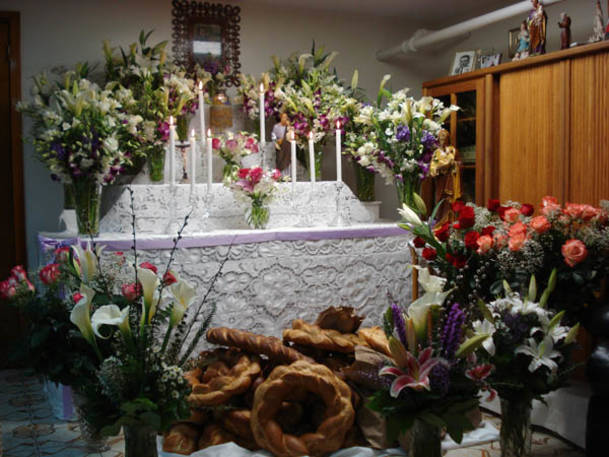March 19th is the Catholic feast day of St. Joseph and in Sicily and through the diaspora, Sicilian devotees assemble temporary domestic altars often as a votive offering in thanks for heavenly intervention. In places like Detroit, New Orleans, and in the Brazo Valley in Texas descendants of Italian immigrants continue the devotional practice of creating elaborate domestic sacred space. I came to know this Sicilian tradition first in New York City, and then in Gloucester, Massachusetts.
This Sicilian sacred art is characterized by its intense culinary component. The food- laden altars are known as tavole or tavolate (large table) due to its cornucopic spread of Sicilian specialties. Beginning in 1978, Giuseppina Maia of New York City created an annual altar consisting of an embroidered table cloth, flowers, candles, sea shells, religious statues, and a framed print of St. Joseph and the Christ Child. Her tavolata also held offerings of sculptured breads, vegetables like cardoons, fruits like oranges and pineapples, and trays of meatless Sicilian specialties such as spaghetti with hard boiled eggs and asparagus, cod fish, and rice with bread crumbs and sugar prepared by Giuseppina and her female relatives and friends over the course of two weeks. They collectively cooked the fifty pounds of pasta, the twelve pounds of rice, and other dishes served to the scores of visitors who attended the sacro-gastronomic fete. It was only after her sisters-in-law developed various health problems did Maia stop preparing her domestic tavolata in 2001.
In this country, it is the Sicilian tradition that has been best documented, while variations of this devotional art form from the continent as practiced in the United States have received less attention. For a quarter century, two families in Sheapshead Bay, Brooklyn create St. Joseph’s altars in their respective finished basements with a distinctly Barese flair, which I had the good fortunate of witnessing last night.
Sister-in-laws and neighbors Angela Rizzi and Antonietta Vitucci, both from Grumo Appula (Bari province, Puglia) continue a tradition inherited from their respective mothers and grandmothers, in what folklorist Kay Turner calls “a matrifocal legacy of religious custom” (Beautiful Necessity: The Art and Meaning of Women’s Altar, 1999). The focus of both altars is religious imagery past down through the decades from mother to daughter. While these are not expressly votive altars created for a specific vow, they are none the less powerful sites of channeled religious sentiment. Antonietta choked up while explaining her deep belief in St. Joseph’s intervention in our mundane world.

Angela’s and Antoinette’s cloth draped, tiered altars are decorated not with offerings of food as in the Sicilian tradition but with numerous vases of cut flowers. They are up at 4AM to purchase the choicest roses, orchids, calla lilies, birds of paradise and other sumptuous flowers from floral wholesalers in New Jersey. Each year Angela receives two vases of flowers from an anonymous donor in the name of St. Joseph. The altars’ bilateral tripartite arrangement, what folklorist Henry Glassie noted is the classic European folk aesthetic, is shared with their Sicilian counterparts.
Loaves of blessed bread, some shaped as a staff and as a circle, were piled on a white cloth at the foot of both altars. These were distributed to friends and family (and the ethnographer) who paid a nocturnal social visit. We were all treated to a variety of homemade liquors and taralle, dried chick peas, and endless trays of cookies.
A few months ago, I was talking with a young scholar of Italian-American history about my research on religious practices in Italian New York City and she was incredulous that Italian-Americans maintained altars, marched in processions, and prayed to the saints in hopes of a miracle in 2007. In a voice of utter astonishment and just a tinge of contempt, this scholar of Italian-Americans’ past ask me rhetorically, “They still do that?!”
Despite the statistics and surveys that inform us that the vast majority of Italian-Americans have long ago become assimilated Catholics (or Episcopalians, or Buddhists, or apostates), and despite the American implementation of the Second Vatican Council in which, as historian Robert Orsi notes, “the saints and the varied practices of sacred presence were repositioned in the firebreak between then and now to serve as gatekeepers for the otherness of the past” (“‘The Infant of Prague’s Nightie’: The Devotional Origins of Contemporary Catholic Memory” U.S. Catholic Historian 21.2, Spring 2003, 1-18), Italian Catholics still continue to give creative expression to the sacred presence in the lives.
Italian-Americans’ relationship to the divine has not remained static but has changed in context and meaning over the past 125 years in a place like New York City. The rich legacy of Catholic folk art and vernacular sacred space of tenements, alleyways, and teeming festa streets of the immigrant slums has long been adapted to rented apartments and the overwhelmingly privately owned homes and property in the more suburbanized neighborhoods in the outer boroughs. The historic economic deprivation has ended as Italian Americans journeyed from destitute immigrants to the (relatively) safe and resource-filled environs of white, middle class status.
It’s not useful to wistfully “celebrate” contemporary religious practices as quaint “folk traditions” from the Italian or immigrant past. (“They don’t even do this in Italy any more!” is a stock quote from visiting Italians that says more about them than it does about actual religious practices in Italy or the United States.) Listening to what people say about their beliefs and honestly observing what people actually do as part of their religious world provides a more accurate portrait of religion as it is lived in this historic moment at the onset of the 21st century.
Evviva San Giuseppe!




